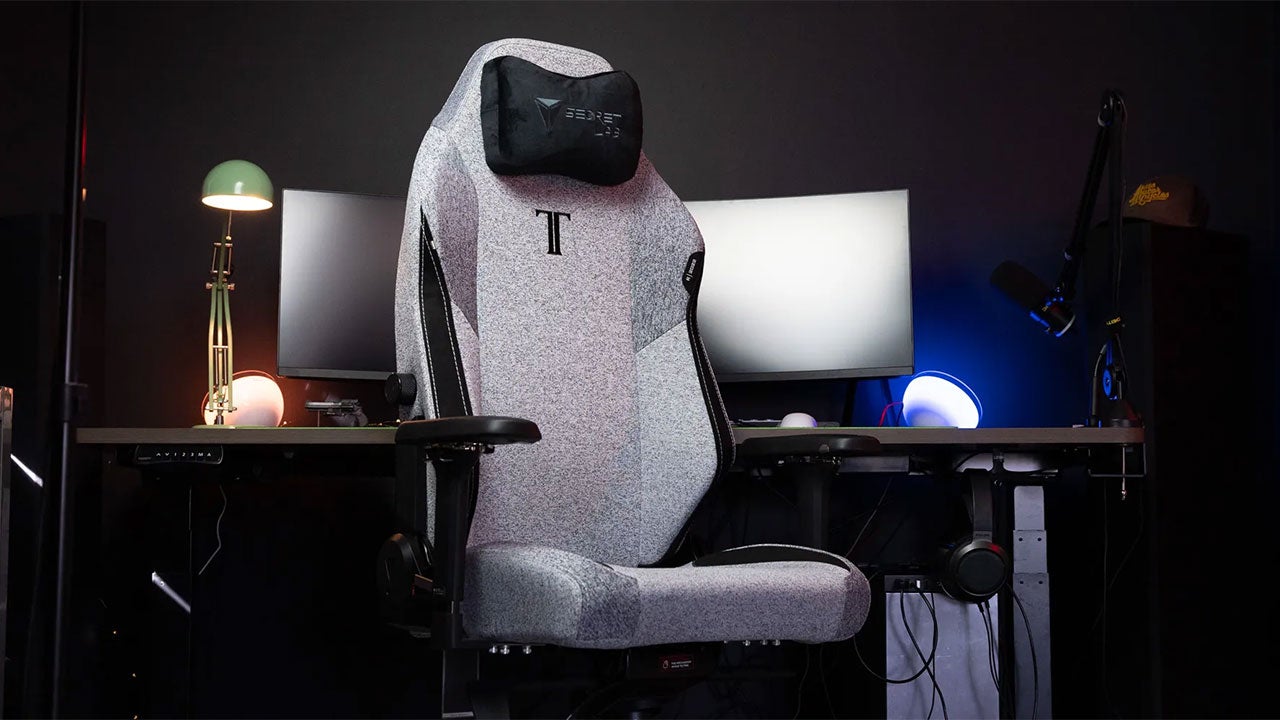Corsair’s Virtuoso lineup of gaming headsets has always put sound quality first, and that’s never been more true than with the Virtuoso Pro. Its latest symphonic headset features improved 50mm graphene drivers, enhanced comfort, and open-back ear cups for a spacious listening experience that doesn’t rely on virtual surround sound. At $199, they’re expensive for a wired headset, but you may just want to use these as your everyday headphones too.
Corsair Virtuoso Pro – Design and Features
The Corsair Virtuoso Pro makes a great first impression. The unboxing experience is much closer to a nice pair of audiophile headphones than a gaming headset. They come in a large, zipped carrying case with a protective hardback shell. Inside, the headphones are held safely in a molded foam tray. Its cables tuck away in a mesh pocket on the top half of the case, held closed with velcro. I was reminded of the Drop Panda, a $400 pair of planar magnetic headphones, but similar cases are found throughout the audiophile world: the Bowers & Wilkins PX8 ($660), the Focal Bathys ($699), the HIFIMAN Ananda Nano ($599). Each of these headphones is designed to be a daily companion, and that’s exactly the case with the Virtuoso Pro.
It blends form with function but with an eye toward balancing robust build quality with a comfortable light weight. Its open-back cups are intricately designed and look magnificent. Rather than use simple mesh grilles, the backs have precision-cut aluminum faceplates, revealing the driver within. There are layers to its design, inviting you to peek behind the curtain (grille) at the driver below. The dark metal bracing on the driver lines up with a lighter outer ring on its face, drawing your eye to the metal yokes, accented with gleaming silver bezels. Centered beneath the grille is a Corsair sails badge that you might miss at first glance.

Put another way, it’s a uniquely stellar-looking headset that could easily pass for a high-end pair of headphones. If you don’t know what to look for, there really isn’t any clue that it’s a gaming headset at all. Which is perfect, because you truly may want to take these on the go. Not only does the price make that a compelling option, but they sound good enough that they could genuinely be an upgrade to your current pair of headphones or earbuds. Assuming you don’t mind the wire, of course.
Much of the improvement to its sound can be attributed to its brand-new driver system. The Virtuoso Pro uses 50mm drivers that are 25% larger than many of the best gaming headsets, including the excellent Arctis Nova Pro Wireless. Larger drivers are able to move more air and typically improve their response (in this case, 20Hz to 40kHz). But, like other areas in life, it’s not just size, it’s how you use it.
Prior Virtuoso models also used 50mm drivers, but the Pro now uses graphene diaphragms. A speaker’s diaphragm is its cone, making up the surface between its large outer ring and its core, vibrating to create sound. Graphene is lightweight yet rigid, allowing it to start and stop on a dime for improved detail and resolution. These same qualities allow it to extend further into the bass and treble, providing more detail and texture to the listening experience. Compared to past Virtuosos, it’s an immediately noticeable improvement and makes the headset sound clearer than ever before.
The other half of its sonic improvements come from its open-back design and the spacious listening experience it creates. Its wide-open grilles allow sound to escape out the back, which creates a much more spacious listening experience. The soundstage is much wider and more natural than most closed-back gaming headsets, including in Corsair’s own line-up. The downside is that it also lets sound in, so it’s not isolating and everyone around you will know exactly what you’re listening to.

In the mesh pocket on the top of the case, you’ll find three detachable audio cables with a fourth available as an optional purchase from Corsair. For gaming and streaming, the mic cable adds a flexible unidirectional mic to the left earcup. When you don’t need a mic, or have a separate one on your desk, there’s a standard 3.5mm cable. A splitter cable is also included if you want to break out the microphone and headphone connections. For dedicated listening setups, Corsair also sells a 4.4mm balanced cable to connect to higher-end DACs and amps, but since these headphones don’t require much power to drive, it’s not a must-have purchase.
The headphones are well-built and exceptionally comfortable. The headband, yokes, and grills – all of the common breakage points – are reinforced with metal. The earcups themselves are plastic, which helps keep it to a reasonably lightweight 338 grams. The cushions and headband are soft and cloth-lined for breathability. The grip force is fairly strong but wasn’t uncomfortable and helped the headband distribute its weight. I have short hair and the top of my head gets sore from headphones easily, but I was able to wear the Virtuoso Pro for upwards of five hours without any discomfort or soreness.

The headband, cushions, and even the grilles are also user-replaceable. If they ever wear out, presumably Corsair will sell replacements like it’s done for past models. If not, third-party stores like Wicked Cushions are likely to fill the void if the headset is successful.
Finally, we have the microphone, which is unidirectional and noise canceling. After testing it extensively, I’m a bit mixed on it. While it sounds fairly good with only a small amount of compression, I found its level to be too quiet when plugged directly into my PC. Your teammates will be able to hear you, but I had to turn the microphone all the way up to achieve that level, so there’s virtually no headroom at all to make adjustments.

If you happen to have an Elgato Wave XLR or another interface that provides more power to the microphone, this issue disappears entirely. It also allows you to take advantage of VST plug-ins like Nvidia Broadcast for enhanced background noise suppression. You can also increase its gain using filters and plug-ins in OBS, but without a preamp, it can become a bit noisy and start picking up sounds like your gaming keyboard.
All of that to say, the mic is fine but needs more power and depending on how you achieve that, your mileage may vary.
Corsair Virtuoso Pro – Performance
Even more than most other gaming headsets, the Virtuoso Pro lives and dies on its sound quality. And my friends, it lives. The Virtuoso Pro is one of the best sounding gaming headsets I’ve heard, ranking right up there with the Arctis Nova Pro Wireless, which has its own separate DAC, and the Audeze Penrose, with its large planar magnetic drivers.

The new dynamic of carbonized drivers and open-back spaciousness lend the Virtuoso Pro a simultaneously rich yet airy listening experience. The bass is full and wide with defined, clear punchiness. Explosions have a poignancy and thump that’s impactful and immersive. Playing Battlefield 2042, the action felt downright visceral. Pounding grenades and tank blasts start and stop with impeccable speed, revealing the cacophony of destruction, return fire, shouting, and frenzied footsteps. In a word, it’s defined.
The Pro doesn’t get lost in its low-end, however. It’s actually remarkably well-balanced, with slightly forward mids and sparkling highs. Footsteps and comms all come through the mids. Even in the midst of utter chaos, I was still able to pick out the sound and position of enemy footsteps. If you’re chatting on Discord, you can count on those comms cutting through no matter what’s happening on screen.
The open-back cups and spacious highs enhance the soundstage and seem to stretch out the layers of what you’re listening to. I’ve been spending a lot of time in Starfield and the strains of ship battles stand out most to me. Free of the added noise of interior environments, I could really appreciate how wide the listening experience was. The subtle reverb of missiles and ballistics flying through space, how enemy comms seemed to come from a distance away, the way the lonesome rush of my engines almost seemed to wrap around me as I flew toward planets and through asteroid fields – these are qualities that closed-back headsets rely on virtual surround sound for and sometimes bungle with over-done reverb. Here, it’s all hardware, all-natural, and very well done.

What’s especially interesting is the middle-ground Corsair has found between gaming and music. The song, Exhausted by Jonny Craig is a perfect example of what this headset does well when used as normal headphones. The bass is powerful but not overwhelming and is rich with texture, similar to a subwoofer. At the same time, the hi-hats cut through, the synths ring out with excellent, wide positionality. The vocals come right to the forefront, perfect for pop and hip-hop.
If you’re a fan of rock or metal, the Virtuoso Pro is able to keep up with even the busiest of tracks. Dance Gavin Dance’s The Ghost of Billy Royalton highlighted their layering ability. Even in the midst of pounding drums, screaming vocals, and frantic guitar riffs, every layer was perfectly audible. You can hear exactly how your favorite tracks are composed, even with elements that usually blend together, like layered vocals.
Just don’t use them with other people around. These headphones sound best when they’re loud, but even at 40%, they bleed sound so bad that any passerby will be able to pick out the dialogue in your cutscene. Likewise, you’ll hear everything around you without the volume turned way up. It goes with the territory for open-back headphones but is definitely a limitation if you’re not able to game in solitude.






